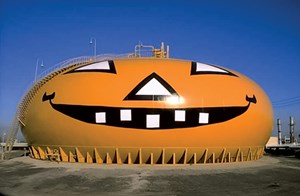Halloween, or All Hallows’ Eve, is just around the corner. It’s a night in late October, when we in the West dress up in weird, scary attire (the more macabre and horrifying, the better), and wander our local neighborhoods begging for treats.
Since the success of the begging is related directly to the ghoulishness of the costume, considerable thought must be given to attire. After some thought, I have decided on a costume for this year that should confound, frighten and annoy even the most stalwart individual. I am dressing as an employed oil and gas industry professional. I toyed with dressing as a growing and vibrant Chinese economy but, despite the need to shock, some things remain off-limits.
I had other options. I considered going as a once-prosperous oil and gas company, whose only hope now is to be the subject of an acquisition. Since oil and gas companies appear to be a more attractive acquisition prospect than individual assets—according to Oil Search Ltd. Managing Director Peter Botten—due to the dramatic fall in their value, the costume would score well in the “scary” category, especially in Houston.

I considered dressing as a service/supply company. Given current conditions, the costume would include gaping sores, dripping skin, protruding bones and lots of blood. It also would probably require lying completely still on the ground, so as to mimic the lifeless state of many of that genre. But, I am not sure that the neighbors’ kids would understand.
Or I could dress as an Australian shale prospect. This would require a very small costume, allowing a lot of nudity. It’s a character that was once dressed in rich fabrics woven by the likes of Chevron and Statoil, but it is now dressed in hand-me-downs since the big boys went home, and took their nice attire with them.
If I want to really terrify, I would go dressed as a drilling budget, or any oil and gas budget for that matter. Speaking at the Pipeline and Energy Expo in Tulsa in late August, Wood Mackenzie’s V.P. of integrated energy, Skip York, noted, “we’ve been thinking for three or four months that 2016 budgets would be smaller than 2015. Now we think they will be even smaller.” That should lead to a production drop next year, according to York. Since the budgets continue to shrink, I should wear this costume this year, while we fiddle with the rig count.
As of this writing, drillers have added rigs in U.S. fields, even as the price of oil plummets. According to the Baker Hughes rig count, rigs drilling for oil rose by two in the fourth week of August, to 674. The Williston play added three rigs, to bring their total to 73, while the Permian basin and the Eagle Ford combined for an eight rig loss. Given York’s predictions for 2016, this year’s costume should be elaborate, with a fur coat thrown in for emphasis. Looks like next year’s costume might be just a pair of underwear.
I seriously considered going as the price of oil, but I just couldn’t figure out how to make the costume. I toyed with replicating the contents of a sewer but that was too disgusting, even for the current price of oil. I thought of making a costume that mimicked a roller coaster, but that was too difficult. I could dress as a huge question mark, but that is mundane. I could dress as an oil price pundit, but the range of costume options is just too broad, and none of the dress options would be easily defendable.
So, I just don’t know how to handle Halloween. There are numerous oil and gas dress options, many of which would strike fear into the heart of any normal person. But, I can’t make a decision. I guess I will go dressed as myself. That should be scary enough.
Water issues, volume 2. I had a nice email exchange with Allen E. Arnold, operations manager at XTO Energy, in late August. Allen read last month’s column on water use and noticed an important area that I did not mention. I am including his comments here, because the facts that Allen sent are very important in supporting the industry’s record of stewardship in water conservation and treatment issues.
As Allen noted, “An additional fact that relates to this topic is too often not included in the discussion. When natural gas is combusted, in addition to the heat energy that is produced, we also get CO2 and H2O. In fact, each molecule of CH4 combined with two O2 molecules results in one CO2 molecule and two brand new H2O molecules that are introduced to the hydrologic cycle. Each Bcf of gas combusted produces about 11 million gallons of new water.”
“Said in other words, a gas well that requires 250,000 bbl of frac water, and produces 6 Bcf EUR, will result in 1,571,000 bbl of water added to the cycle—more than six times the water used to fracture it. So, while those greater demand users of water (primarily agriculture) are arguably cycling the vast majority of it within the hydrologic cycle, and fracturing does strand some underground, only the fossil fuel industry is actually a net contributor to the cycle.” Thanks Allen. ![]()

- What's new in production (February 2024)
- Prices and governmental policies combine to stymie Canadian upstream growth (February 2024)
- U.S. operators reduce activity as crude prices plunge (February 2024)
- U.S. producing gas wells increase despite low prices (February 2024)
- U.S. drilling: More of the same expected (February 2024)
- U.S. oil and natural gas production hits record highs (February 2024)


